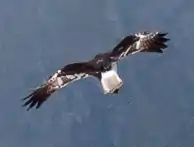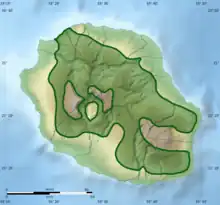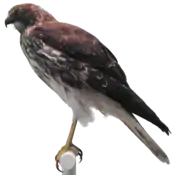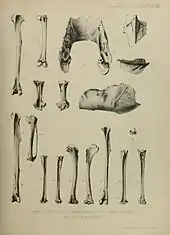| Réunion harrier | |
|---|---|
 | |
| Male in flight | |
| Scientific classification | |
| Domain: | Eukaryota |
| Kingdom: | Animalia |
| Phylum: | Chordata |
| Class: | Aves |
| Order: | Accipitriformes |
| Family: | Accipitridae |
| Genus: | Circus |
| Species: | C. maillardi |
| Binomial name | |
| Circus maillardi J. Verreaux, 1862 | |
 | |
The Réunion harrier (Circus maillardi), also known as Réunion marsh harrier, is a species of bird of prey belonging to the marsh harrier group of harriers. It is now found only on the Indian Ocean island of Réunion, although fossil material from Mauritius has been referred to this species. It is known locally as the papangue or pied jaune. The Malagasy harrier (C. macrosceles) of Madagascar and the Comoro Islands was previously treated as a subspecies of this bird but is increasingly regarded as a separate species. The Réunion harrier appears to be declining in numbers and it is classed as an endangered species.
Description

It is about 42–55 cm long; the female is around 3–15% larger than the male.[2] The male has a blackish head and back with white streaks. The underparts, underwings and rump are white and the tail is grey. The wings are grey and black with a white leading edge. Females and immatures are dark brown with a white rump and barred tail.[3]
The birds are mostly silent except during the breeding season when they give a chattering threat call, a wailing courtship call and chuckling food-associated calls.[2]
The Malagasy harrier is larger and paler with longer wings and legs.
Ecology
It is typically found in forested upland areas between 300 and 700 m above sea-level.[3] It also visits cane fields and grassland. Today its diet includes many introduced mammals (rats, mice and tenrecs) but it originally fed mainly on birds and insects.[3] It will also take small lizards, frogs and carrion.[2][3] It has a number of adaptations which are unusual among harriers: broad rounded wings for hunting between trees and a short tarsus and long claws, which are common among those birds of prey which feed on other birds.[4] It breeds between January and May and lays two or three white eggs in a nest on the ground.[3][5]
Status and conservation
In 2011 it had an estimated population of at least 564 birds including about 150 breeding pairs.[3] It has been evaluated as endangered by BirdLife International and it is threatened by destruction and disturbance of its habitat and by poaching, deliberate persecution and accidental poisoning by rodenticides.[3] It became a protected species in 1966 and its numbers were thought to be stable or increasing until 2000–2010 when its population appeared to decrease.[3]
Sites identified by BirdLife International as being important for the conservation of the species are the Important Bird Areas (IBAs) of:[6]
Taxonomy

The species was described in 1862 by Jules Verreaux. He named it in honour of Louis Maillard, a French botanist and engineer who mentioned the bird in a book about the island.
In 1893 Alfred Newton and Hans Gadow described tarsometatarsi, tibiae and metacarpals from a hawk called Astur alphonsi (later renamed Accipiter alphonsi and Circus alphonsi) from Mauritius.[7] In 1958 James Greenway considered this taxon as conspecific with the pied harrier.[8] A later examination of the bones came to the conclusion that Astur alphonsi is actually identical with Circus maillardi, which formerly occurred on Mauritius too but is now extirpated.[9]
In 2015, Graeme Oatley, Robert Simmons and Jerome Fuchs [10] in their complete DNA re-analysis of the 16-member Circus genus, concluded that despite the recent divergence and close genetic similarity of the Madagascar Harrier Circus macrosceles, and Reunion Harrier Circus maillardi their geographic and morphological differences suggests that the species should be elevated to species status. Depending on accepted mutation rates the two species diverged between 300 000 and 100 000 years ago, and Reunion Harriers evolved features enabling capture of birds and bats in the forested habitat.
References
- ↑ BirdLife International (2016). "Circus maillardi". IUCN Red List of Threatened Species. 2016: e.T22728310A94979400. doi:10.2305/IUCN.UK.2016-3.RLTS.T22728310A94979400.en. Retrieved 12 November 2021.
- 1 2 3 Ferguson-Lees, James & David A. Christie (2001) Raptors of the World, Christopher Helm, London.
- 1 2 3 4 5 6 7 8 BirdLife International (2014) Species factsheet: Circus maillardi. Downloaded from http://www.birdlife.org on 26 January 2014.
- ↑ Clarke, Roger (1995) The Marsh Harrier, Hamlyn, London.
- ↑ Barré, Nicolas; Armand Barau & Christian Jouanin (1996) Oiseaux de la Réunion, Les Éditions du Pacifique, Paris.
- ↑ "Reunion Harrier". Important Bird Areas factsheet. BirdLife International. 2014. Retrieved 2014-03-07.
- ↑ Rothschild, Walter (1907) Extinct Birds, Hutchinson & Co., London.
- ↑ Greenway, James (1958; 1967 for the 2nd edition) Extinct and Vanishing Birds of the World, Dover Publications.
- ↑ Mourer-Chauviré, Cécile; Roger Bour & Sonia Ribes (2004) "The taxonomic identity of Circus alphonsi (Newton & Gadow 1893), the extinct harrier from Mauritius", Ibis, 146 (1): 168-172.
10. Oatley G, Simmons RE, Fuchs J. 2015. A molecular phylogeny of the harriers (Circus, Accipitridae) indicate the role of long distance dispersal and migration in diversification. Molecular Phylogenetics and Evolution 85 (2015) 150–160. http://dx.doi.org/10.1016/j.ympev.2015.01.013
